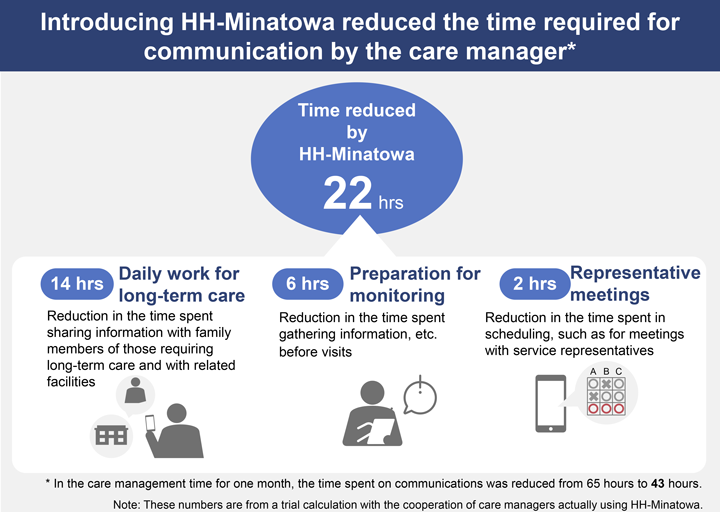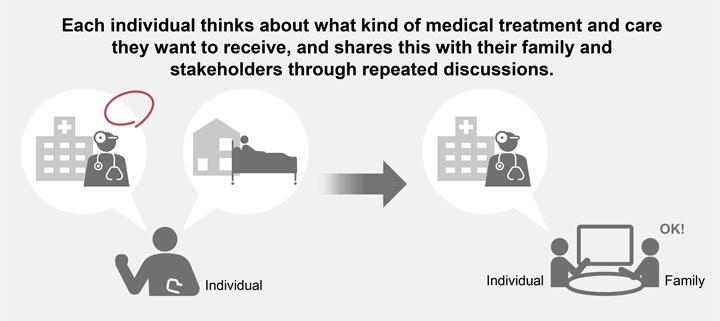Featured customer case
Lumada customer case code: UC-01981S
—Smooth collaboration among stakeholders involved in home care improves operational efficiency and the quality of care—
2023-09-13
Using ICT to support the construction of an integrated community care system
There are regional differences in the aging situation. Even if a person is in severe need of nursing care, an integrated community care system that is tailored to the actual situation of the area is needed in order for the person to live in their own way in the community familiar to them.
Hitachi has achieved sharing of information in the cloud among long‑term care recipients, their families, and stakeholders across multiple disciplines. This enabled smooth collaboration, which both improves the efficiency of medical and care operations and also improves the quality of that care. In addition, we have reduced the risk of identity theft and unauthorized access by strengthening security through encryption of communications and multi‑factor authentication, thereby enabling the construction of highly secure integrated community care systems.
For local governments, Hitachi can provide mechanisms to securely share data held by the local governments via the cloud. We can enable information collaboration among stakeholders and can improve the efficiency of home care services. In addition, since local government data includes information unique to the region, it is possible to build an integrated community care system that suits the actual situation of the region. For details of cloud solutions for local governments, see ICT Solution for Community‑based Care System (in Japanese).
With private customers, as in the case of the Hankyu Hanshin Minatowa project, which will be introduced below, we have been advancing the collaborative creation of community‑based services while listening to opinions and requests from long‑term care recipients, their families, and stakeholders.
Hankyu Hanshin Holdings, Inc. (hereinafter abbreviated to HHH Inc.) is working to create the means to extend healthy life expectancy and to enable people to live to a rewarding old age. In collaboration with Hitachi, HHH Inc. is working on the Hankyu Hanshin Minatowa (hereinafter abbreviated to HH‑Minatowa) system which is currently being deployed. HH‑Minatowa is a community‑based comprehensive care support service that supports the provision of optimal long‑term care services while safely handling personal information based on the consent of the long‑term care recipients.

HHH Inc. and Hitachi have agreed to expand and deepen their HH‑Minatowa initiatives. With the cooperation of the Osaka City Miyakojima Medical Association, we have started a demonstration project aimed at preventing the worsening and recurrence of heart failure, diabetes, and osteoporosis by utilizing a PHR*2 app and a Community Cooperation Handbook.
HH‑Minatowa is linked to the PHR app, which can collect and utilize information on patient health, medical care, and long‑term care, and is also linked with the Community Cooperation Handbook for heart failure patients. This enables the families and stakeholders involved in medical care and long‑term care to understand the patients’ situations in a timely manner. By entering vital‑signs data and questionnaire results into the PHR app or Community Cooperation Handbook, patients themselves obtain a higher awareness for self‑management. In addition, by sharing the entered data quickly, safely, and reliably with medical institutions and long‑term care offices via HH‑Minatowa, it becomes possible to consider the optimum treatment and care.
In the demonstration project, we will verify the feasibility of this system with regard to the following two points.
Based on the results obtained from this demonstration project, we plan to proceed with the next demonstration project.
In the future, through DX (digital transformation) in the healthcare field, HHH Inc. and Hitachi will continue to contribute to the development of medical businesses and businesses that reduce the need for long‑term care, while contributing to the development of the means to extend healthy life expectancy and of communities. HHH Inc. and Hitachi have the goal of developing service businesses in this field by using the PFS (pay for success) model. In the PFS model, government services are outsourced to private businesses and the remuneration paid is determined according to how much medical costs are optimized.

ACP (Advance Care Planning) is an initiative in which individuals, in preparation for future illness and long‑term care, think about what kind of medical treatment and care they would want to receive, and share this with their families and stakeholders through repeated discussions. The aim is to ensure specific medical treatment and care in accordance with the wishes of the individual. This process requires, for example, ensuring the individual receives sufficient explanations about the disease from the doctor, ensuring they can select their treatment method, ensuring they obtain various types of information about long‑term care services, and making sure they consider in advance the form of care they want.
Facilitating communication among stakeholders through HH‑Minatowa and raising awareness of self‑management through the use of the PHR app and the Community Cooperation Handbook will lead to the spread and advance of ACP. By practicing medical care and other care that respects the wishes of the individual, we expect that not only the individual but also their family will gain an improved sense of security and satisfaction.
For details on our solutions, see the following webpages.
Hankyu Hanshin Minatowa is a system that facilitates communication among stakeholders through information sharing using the cloud. The system has improved the operational efficiency of medical care and long‑term care and has improved the quality of home care in Japan, which has a declining birthrate and an aging population. Mechanisms for patients to enter the data to be shared with stakeholders can be added to this system, which can lead to ACP (Advance Care Planning). ACP raises the awareness of patients towards self‑management and enables them to select the treatment methods and long‑term care services that match their wishes.